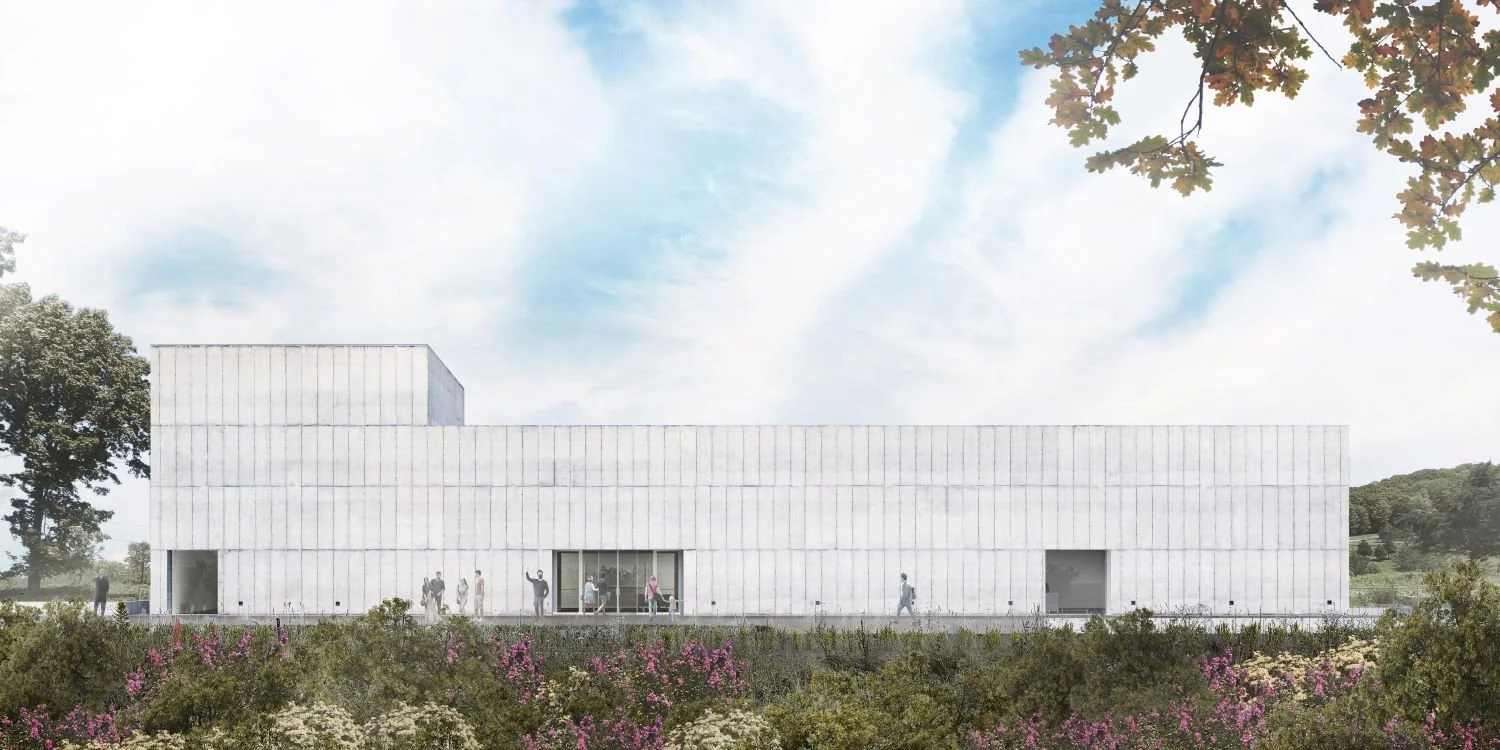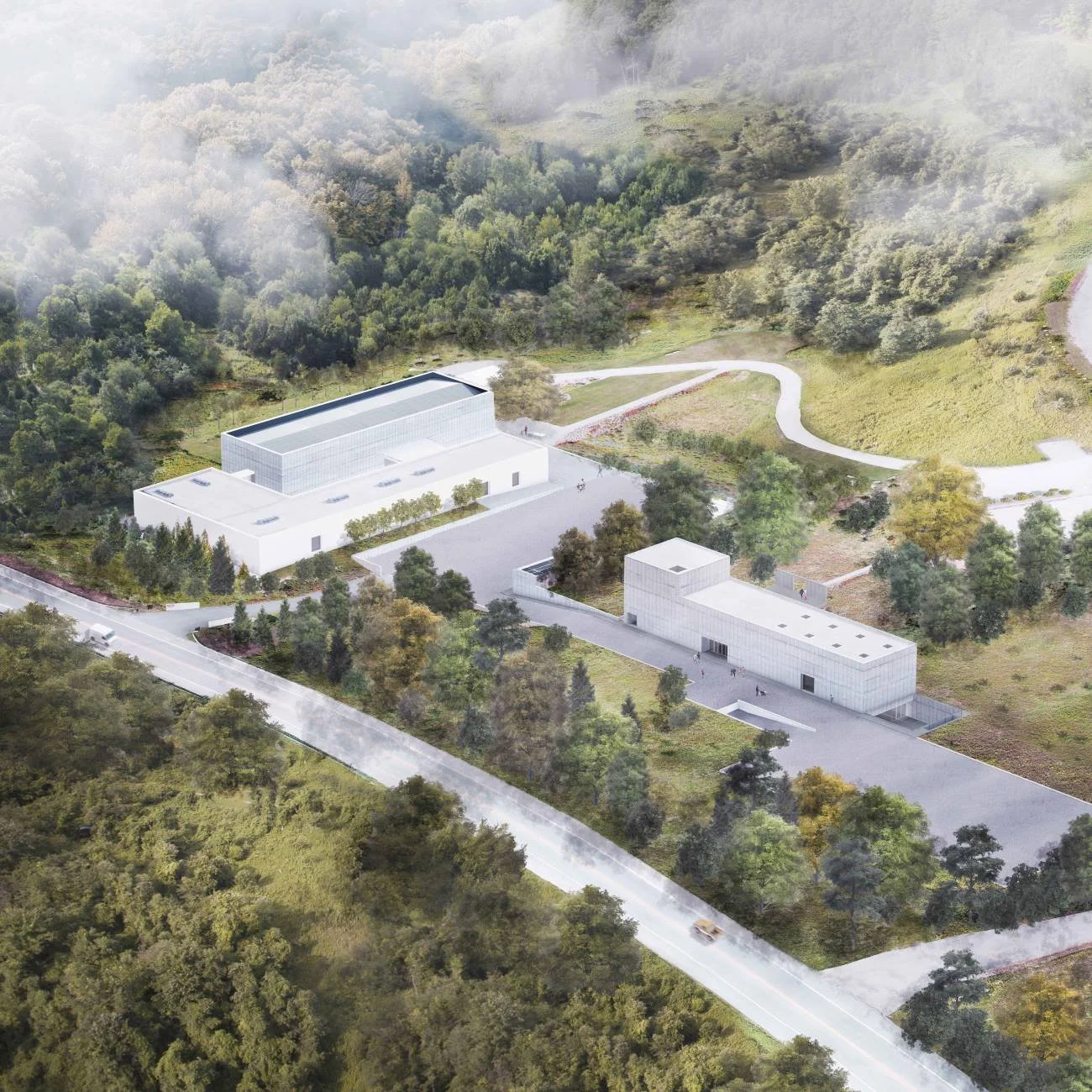Magazzino unveils the Robert Olnick Pavilion, designed by Alberto Campo Baeza and Miguel Quismondo
By Emily Conklin
Sep 14, 2023
It began its life as a computer chip warehouse facility off of Route 9 in Cold Spring, New York, a small town with a Metro-North train station and a few restaurants on its main street. Magazzino means “warehouse” in Italian, playing off this industrial past of the site, but the Magazzino Italian Art museum has been committed to refined elegance since it first opened its doors. What may have once seemed like an odd geographic choice for a hyper-niche collection of nation- and movement-specific artwork was actually just one of several arts institutions that began the Hudson Valley’s art destination explosion. This week, the museum shows just how far they’ve come with the Robert Olnick Pavilion, the latest addition to their growing campus.
First opening its doors in 2017, it housed a collection of midcentury Italian art (notably collections of Arte Povera), many pieces which had never been seen before in the United States. All are from the collection of Nancy Olnick and Giorgio Spanu. (The pavilion is named for Olnick’s father, Robert.) Yet while the arts institution often hosts film screenings, live music and community dinners, the primacy of the permanent collection—in the somewhat compact digs of the magazzino—never allowed for more dynamic programming. The small internal courtyard nestled between the taller concrete wing and the low-slung white mass was never quite enough. The long-awaited unveiling of the Robert Olnick Pavilion just up the hill set out to change that.
Designed by Spanish architects Alberto Campo Baeza and Miguel Quismondo, this new pavilion is a stylistic twin to the main concrete form that began the transformation of the highway-adjacent grounds. Olnick and Spanu have been patrons of the architects for some time: Campo Baeza designed their home in Garrison, which completed in 2008, and Quismondo designed the original Magazzino building.
The addition turns the Magazzino into a proper “campus.” The building’s opening celebration, held last Sunday, was met with the same reliable pomp and luxe of any Magazzino event: This is an institution that will never serve you coffee in a paper cup, and has a fleet of glassware specific to whites, reds, and bubbles.
As such, it’s no surprise that the new pavilion sports a five-star Italian restaurant led by chef Luca Galli, whose morning cafe program shares space with a design shop. The cafe is without a doubt the most public-facing aspect of the museum. One can saunter in directly from the hilly grounds behind both galleries, either from the barns which are home to adorable Sardinian donkeys, (the baby, Dolce, is featured prominently on the museum’s Instagram) or via the lush kitchen garden planted for the purposes of the restaurant programming, supported by larger, offsite plots.
In stark contrast to its surrounding Hudson Valley environs, the new pavilion is faced in the same cast-in-place concrete as its predecessor and is defined by the same orthogonal formwork. Engineered in collaboration with local Cold Spring builders, the form is stark but not monolithic: Each panel ranges from 4- to 8-feet high, in a staggered pattern which draws the eye upwards. The surface is also textured and at times even pockmarked, showing the imperfections of a rough and ready element with minimal aesthetic treatment. The effects come from the material itself.
Inside, the gallerists’ interest in pristine, white-cube space is upheld, differing from the original Magazzino in notable ways: There is no central courtyard, and there are multiple levels to the space. A central stair and elevator brings viewers up and down the three floors of new galleries, but a stair inset in the front exterior court also facilitates circulation.
The Campo Baeza–designed “isotropic room,” however, is the most purely “architectural” accomplishment here. While Campo Baeza pronounced it a crowning accomplishment of his career—its cubic form, 10 meters on a side, is punctuated with small square windows—it felt a bit like the white cubes we’re all familiar with. The equally white, contiguous floor gives the space a feeling of endlessness. Without a throng of partygoers, it might deliver a sense of floating if you found yourself there alone. The monumental works hung here by Ettore Spalletti are meditative, but the opening event wasn’t conducive to performing the internal, soul-searching work recommended by the architect. Instead, it made me wonder how often the staff will have to clean the floor.
Magazzino has closed an important programmatic gap with the new Olnick Pavilion: There is now a proper sense of a campus, space for temporary exhibitions, and a world-class bespoke gallery space. Plus, there is a restaurant and cafe that will no doubt benefit the local community.
Still, emissions responsibility wasn’t mentioned during the opening events. The use of concrete, given cement’s carbon intensity, may not benefit our global community. Cities continue to pour it with abandon, even though there are less extractive (but more expensive) variants available. But its use at Magazzino is merely a drop in the barrel of a mixer truck. Here, the material works to offer permanence: With proper care, the box could be operational for centuries. The most sustainable building is no new building at all, so we can instead imagine what artworks might its cubic meters host in 2223.
Photo credits: William Mulvihill, Marco Anelli/Tommaso Sacconi
Magazzino Italian Art’s Alberto Campo Baeza and Miguel Quismondo–designed addition will open in September
By Chris Walton
Jul 11, 2023
In New York’s Hudson Valley, museum and research center Magazzino Italian Art will be opening a Alberto Campo Baeza and Miguel Quismondo–designed Robert Olnick Pavilion on September 14. Magazzino focuses on postwar and contemporary Italian Art, making it the only museum to do so in the U.S.
Since 2017, Magazzino has been housed in a 20,000-square-foot building designed by Spanish architect Miguel Quismondo. In 2020, Magazzino announced plans for the additional 13,000-square-feet of exhibition space with the Campo Baeza expansion, which Quismondo is also working on. The institution sits on 9.5 acres in Cold Spring that includes a stable of Sardinian donkeys.
The pavilion was designed as a rectangular prism. It is set into a sloping landscape, with additional height at one end. In addition to two gallery spaces, the pavilion includes a multipurpose room that can serve as an auditorium, and a cafe and store. One gallery will be devoted to “Italian decorative arts, Murano glass, ceramics, and jewelry.”
The second gallery, in the wing with the extended ceiling, was designed by Campo Baeza as an “isotropic room.” Set within a perfect cube, square windows set in the room’s corners permit natural light, creating a “sundial” effect throughout the day.
In a statement, Campo Baeza said: “We built the Robert Olnick Pavilion like a poem: a white cube traversed by light. The main space will embody the beauty of the artwork it exhibits, and with an isotropic design that carves an opening into every corner, each detail will be touched by magnificent sunlight. Not unlike the excitement of birth, it is with great anticipation that we deliver this second building to the museum.”
Throughout the pavilion, concrete finishes and white walls will curate an environment Magazzino desires for its art, and in-line with Campo Baeza’s portfolio. Shaped by carefully punctured windows, the reliance on natural light to fill the concrete-cast spaces gives the feeling of a garage, and while important for the preservation of the artwork itself, retains the galleries as a place to view art rather than to photograph the surrounding landscape through a more glass-forward approach.
The pavilion will open with Mario Schifano: The Rise of the ‘60s, curated by Alberto Salvadori and offering an 80-work retrospective on the postmodernist’s work, and Carlo Scarpa: Timeless Masterpieces, curated by Marino Barovier and including a selection of Murano glass designed by Scarpa from 1926 to 1942. The pavilion will also open with a special project, Ettore Spalletti. Parole di colore, a presentation of Spalletti’s large-scale work as conceived by Fondazione Ettore Spalletti, Salvadori, and Campo Baeza.
Elsewhere in the U.S., Campo Baeza is also working on a commercial building in Miami Beach, and previously designed the residence of Magazzino cofounders Nancy Olnick and Giorgio Spanu with Quismondo.
Photo credits: Marco Anelli
Magazzino Italian Art reveals plans for a stark pavilion on its Cold Spring campus
By Matt Hickman
Nov 23, 2020
Magazzino Italian Art, a nonprofit museum and research center committed to the study and public appreciation of postwar and contemporary Italian art, has revealed significant expansion plans for its campus in Putnam County, New York.
Magazzino tapped Spanish architects Alberto Campo Baeza and Miguel Quismondo for the project, which will add a freestanding pavilion with dedicated space for special exhibitions and public programming to the museum’s existing main building, which opened to the public in 2017 and was also designed by Quismondo. In addition to erecting a new pavilion building, Magazzino has acquired an additional 3.5-acres of land for the art space’s growing hillside campus—now comprised of 9.5 acres—located just east of the center of Cold Spring, a historic village situated on the Hudson River roughly 50 miles north of New York City.
Meant to “foster a dialogue between art, architecture, and the surrounding natural landscape,” per a press release, the rectilinear pavilion will be located adjacent to Quismondo’s monochromatic concrete main building and mirror it in style and form.
The new building will encompass 13,000 square feet, with over 5,000 square feet of exhibition and programming space, including 3,600 square feet spread across two special exhibition galleries on the main level and a smaller gallery for displaying the museum’s collection of Murano glass and ceramics on the lower level; 1,500 square feet of flexible programming space for screenings, lectures, and other gatherings; and a 1,000-square-foot sunken outdoor courtyard adjacent to the event space on the lower level. A cafe and reading room with indoor and outdoor seating will both be situated on the upper level.
“Magazzino was launched with a commitment to serve as a cultural hub and vibrant community resource and to provide opportunities for inspiration and engagement with Italian art and creativity,” said Vittorio Calabrese, director of Magazzino Italian Art, which was co-founded by Nancy Olnick and Giorgio Spanu. “Our program has grown increasingly ambitious over the past three-and-a-half years as we have grown as an institution. The new pavilion will enable us to better serve our community with expanded resources for visitors and provides us flexible spaces so that we can expand our programmatic offerings in Cold Spring.”
Work on the pavilion is due to kick off in the spring of 2021 and will not impact ongoing exhibitions and programming held within the airy 20,000-square-foot main building at Magazzino. Italian for “warehouse,” the institution’s name pays homage to the old computer chip manufacturing facility (and before that a dairy distribution center and farmer’s storehouse) at the site that was repurposed, expanded upon, and transformed into the contemporary Italian art hub that exists today.
“The existing building has been stripped to its basic components, while the addition is built with structural cast-in-place concrete and metal girders, creating a modulated repetition,” explained Magazzino of the main building’s design. “The management of natural light, the different shells and the versatile height of the new structure establishes a distinction between these, while two glass connectors elegantly merge both parts together to allow for simple circulation.”
Public admission to Magazzino has remained free since it first opened in this particularly bucolic stretch of the Hudson Valley, where neighbors in the vicinity include MANITOGA, the National Historic Landmark-designated modernist home and studio of industrial designer Russel Wright, and Boscobel, a Federal-style historic house museum completed in 1808. Just a bit further afield are fellow contemporary art destinations Dia:Beacon (Dutchess County) and Storm King Art Center (Orange County). Reservations are required to visit the Magazzino campus and there are various safety protocols, including wearable tech that enforces social distancing among visitors, currently in place due to the coronavirus pandemic.
“Conceived to complement the existing museum building and reflect its elegant and simple modern design, the new pavilion brings a new dimension to the museum’s evolving campus,” said Quismondo in a statement. “With strategically placed windows and skylights, the building introduces new opportunities for visitors to enjoy the beauty of the campus as it adds much-needed space for the museum’s growing education and curatorial program and allows for the presentation of projects in new formats.”
Photo credits: J.C. Bragado and J. Mingorance
New contemporary Italian art museum opens in Hudson River Valley
By Olivia Martin
Jun. 27, 2017
Magazzino, a postwar and contemporary Italian art museum, opens June 28, joining the ranks of MASS MoCA, Storm King Art Center, and Dia:Beacon in the Hudson River Valley. The museum will house works collected by Giorgio Spanu and Nancy Olnick, who own one of the largest collections of postwar and contemporary Italian art in the U.S. and have been collecting these works since the 1990s. Featured artists include Giovanni Anselmo, Alighiero Boetti, Pier Paolo Calzolari, Luciano Fabro, Jannis Kounellis, Mario Merz, Giulio Paolini, Giuseppe Penone, Michelangelo Pistoletto, and Gilberto Zorio. The museum itself was 10 years in the making and will feature over 400 artworks from the Olnick Spanu Collection and 5,000 books on Italian art.
Magazzino, which means “warehouse” in Italian, is comprised of an old farmers’ warehouse (later turned into a dairy distribution center and then a computer factory) and a new building by Spanish architect Miguel Quismondo. “We said, the new space had one protagonist: The art. [The building] had to be a container that could explain its content,” Spanu said.
This is Quismondo’s first major completed project; he worked under Alberto Campo Baeza on Spanu and Olnick’s home in Garrison, New York. He became involved with Magazzino in 2014, but completed construction (doubling as the general contractor) in 20 months, a process that he described as “very intense” but “a labor of love.”
The architect mirrored the existing L-shape configuration to create a rectangle with a courtyard in the center, allowing copious light to infiltrate the 20,000-square-foot structure. “The container had to be as discrete and humble and mute as possible, but I still played with the dialogue between the existing 1964 structure and the new 2017 structure. The light works in different ways throughout,” Quismondo explained. Open glass hallways connecting the buildings as well as varied ceiling heights offer visitors moments of compression and expansion. The older works, an homage to Italian curator, collector, and gallery owner Margherita Stein in the inaugural exhibition Margherita Stein: Rebel With a Cause are displayed within the smaller of the two buildings, with lower ceilings and an open layout. The newer works, from the late ‘80s onward, are presented in a much larger room with a central axis running through it. Translucent fiberglass ceiling tiles offer diffused, equal lighting that is akin to the now-famous illumination at the Whitney.
Magazzino (2700 Route 9, Cold Spring, NY, 10516) is free to the public by appointment.
https://www.archpaper.com/2017/06/magazzino-italian-art-museum-hudson-river-valley/
New art space dedicated to contemporary art coming to Hudson River Valley in 2017
By Olivia Martin
Sep. 15, 2016
Nancy Olnick and Giorgio Spanu, owners of one of the largest collections of postwar and contemporary Italian art in the U.S., have hired Spanish architect Miguel Quismondo to create Magazzino, an art space dedicated to their collection. The new structure will inhabit a site in the hills of Hudson River Valley in Cold Spring, New York. Quismondo worked under Alberto Campo Baeza to create Olnick and Spanu’s home nearby in 2007.
For the building, the architect transformed an existing L-shape structure into a rectangle with a courtyard at its center; the building features 18,000 square feet of exhibition space, offices, a library, and an orchard. The architectural style is described as “rationalist” and will be a total of 20,000 square feet.
Magazzino, which means warehouse in Italian, will be free and open to the public by appointment and feature more than 400 works and 5,000 publications on Italian art. It will be led by director Vittorio Calabrese and highlights many works within the Arte Povera movement, an avant-garde, conceptual Italian art movement that emerged in the 1960s. This collection has been in the works since the 1990s and will include pieces that range from the 1950s to the present, featuring artists such as Giovanni Anselmo, Alighiero Boetti, Pier Paolo Calzolari, Luciano Fabro, Jannis Kounellis, Mario Merz, Marisa Merz, Giulio Paolini, Giuseppe Penone, Michelangelo Pistoletto, and Gilberto Zorio. Additionally, more than 500 pieces of Murano glass from 1910 to 2010 will be shown.
“Our goal is for Magazzino to be a place for visitors to encounter major works of Italian postwar and contemporary art, as well as a site for researchers to utilize its library, archive, and collection,” Calabrese said in a press release. “A diverse offering of lectures, screenings, and performances will complement these core objectives. Magazzino’s exhibition program will feature both artists associated with the Arte Povera movement and contemporary Italian artists. By fostering a discussion about Italian art, we aim to undo its long neglect in the American institutional context.”
Magazzino is slated to open in 2017, joining the preexisting arts culture in the Hudson River Valley, including the Boscobel, Mass Moca, Storm King Art Center, the Clark, and Dia:Becaon.
https://www.archpaper.com/2016/09/magazzino-art-museum-hudson-valley/






